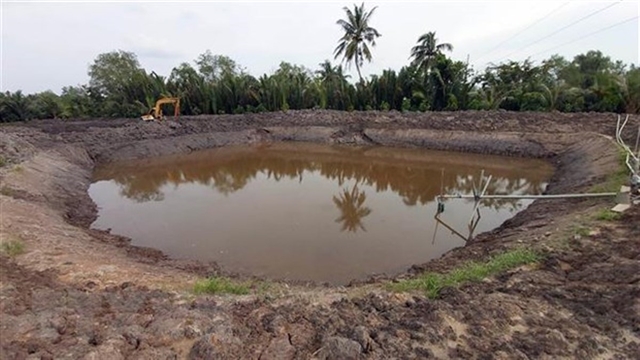 Society
Society


|
| A pond reserving fresh water to prepare the upcoming drought. VNA/VNS Photo |
MEKONG DELTA – Many regions across the country, especially the Central Highlands and Mekong Delta, face risks of water shortage, drought and saline intrusion next month, according to hydrometeorology experts.
The most fierce saline intrusion might occur in Mekong Delta region from February 9 to 15, coinciding with the Tết (Lunar New Year) holiday which may lead to a lack of fresh water.
Water sources from February to July in the river basins in the northern region have been forecast to reduce 20-50 per cent, with the Thao and Lô rivers set to suffer most seriously, said Hoàng Phúc Lâm, vice director of the National Centre for Hydro-Meteorological Forecasting (NCHMF).
In February, the basin of the Hồng (Red) River would be 10-20 per cent lower than the average levels of previous years.
The lowest water level in Hồng River is forecast at 0.2-0.3m in February and March.
From June to July, there will be small and medium floods, with a peak at alarm level 1.
Similarly, in the central and Central Highlands regions, from the second half of January to April, the water levels in the rivers had changed slowly and follow a downward trend.
The water levels of rivers in the provinces of Thanh Hoá, Nghệ An, Quảng Trị, Ninh Thuận and Bình Thuận could be 20-50 per cent lower than in the same period last year.
From May to July, upstream rivers in central and Central Highlands regions are likely to change slowly and fluctuate according to the actions of reservoirs.
The flow discharge on most rivers in regions will be about 10-50 per cent, much lower than the usual average.
Rivers in Nghê An, Ninh Thuận and Bình Thuận will be much lower than average by more than 50 per cent.
“With the trend, the risks of water shortage and drought were likely to occur in provinces of Nghệ An, Ninh Thuận and Bình Thuận and Central Highlands provinces from March to April, and then spread to other central provinces,” said Lâm.
In terms of saline intrusion this year, Vũ Đức Long, NCHMF’s vice director, said the upstream flow towards the Mekong Delta region was decreasing so saline intrusion would increase from the end of this month.
The International Mekong River Commission also stated the total flow in February from the upper Mekong River in Cambodia to the delta region will be 5-15 per cent less than the average volume, and from March to May, the flow will reach the average volume.
The water level of the Mekong River in the dry season this year will vary with the tide and be 0.1-0.3m higher than average.
The severest saline intrusion at the mouth of the Mekong River is likely to happen from mid-February to late March.
For the Vàm Cỏ and Cái Lớn rivers, saline intrusion is forecast in March and April and then will gradually decrease.
The range of saline intrusion at the estuaries of the Mekong River will be about 55-75km.
Saline intrusion in the region depends on the water source from the upper Mekong River, high tide and many other changes, according to the NCHMF.
Therefore, the centre recommended localities in the delta region stay updated on hydro-meteorological forecasts and take proactive measures to prevent droughts and saline intrusion. VNS




